warning light CADILLAC DEVILLE 1998 7.G User Guide
[x] Cancel search | Manufacturer: CADILLAC, Model Year: 1998, Model line: DEVILLE, Model: CADILLAC DEVILLE 1998 7.GPages: 386, PDF Size: 22.36 MB
Page 144 of 386
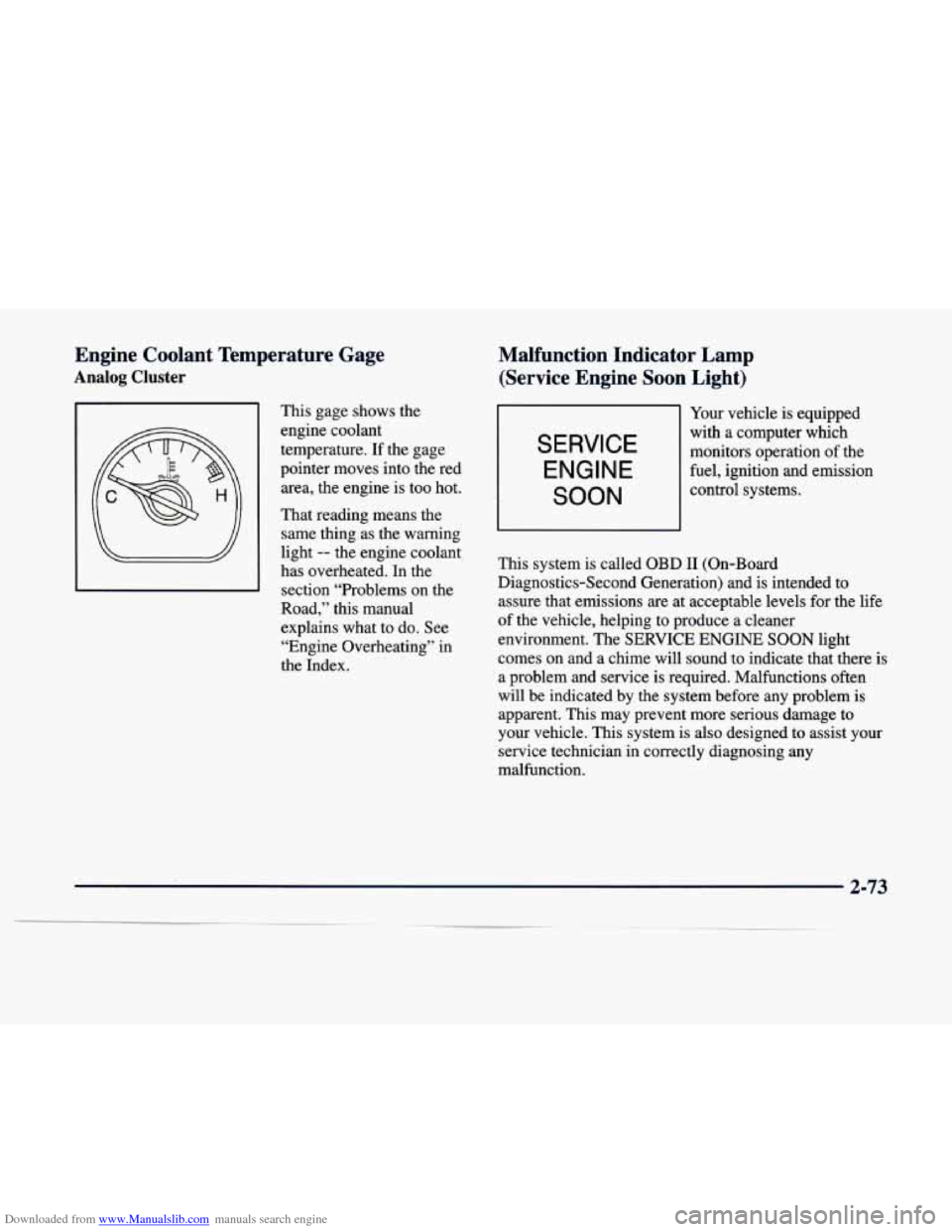
Downloaded from www.Manualslib.com manuals search engine Engine Coolant Temperature Gage
Analog Cluster
This gage shows the
engine coolant
temperature. If the gage
pointer moves into the red area, the engine is too hot.
That reading means the same thing as the warning
light
-- the engine coolant
has overheated.
In the
section “Problems on the
Road,” this manual
explains what to do. See
“Engine Overheating” in
the Index.
Malfunction Indicator Lamp
(Service Engine Soon Light)
Your vehicle is equipped
with a computer which
monitors operation
of the
fuel, ignition and emission
control systems. SERVICE
ENGINE
SOON
This system is called OBD II (On-Board
Diagnostics-Second Generation) and is intended to
assure that emissions are at acceptable levels for the life
of the vehicle, helping to produce a cleaner
environment. The
SERVICE ENGINE SOON light
comes on and a chime will sound to indicate that there is
a problem and service is required. Malfunctions often
will be indicated by the system before
any problem is
apparent. This may prevent more serious damage
to
your vehicle. This system is also designed to assist your
service technician in correctly diagnosing
any
malfunction.
2-73
Page 155 of 386
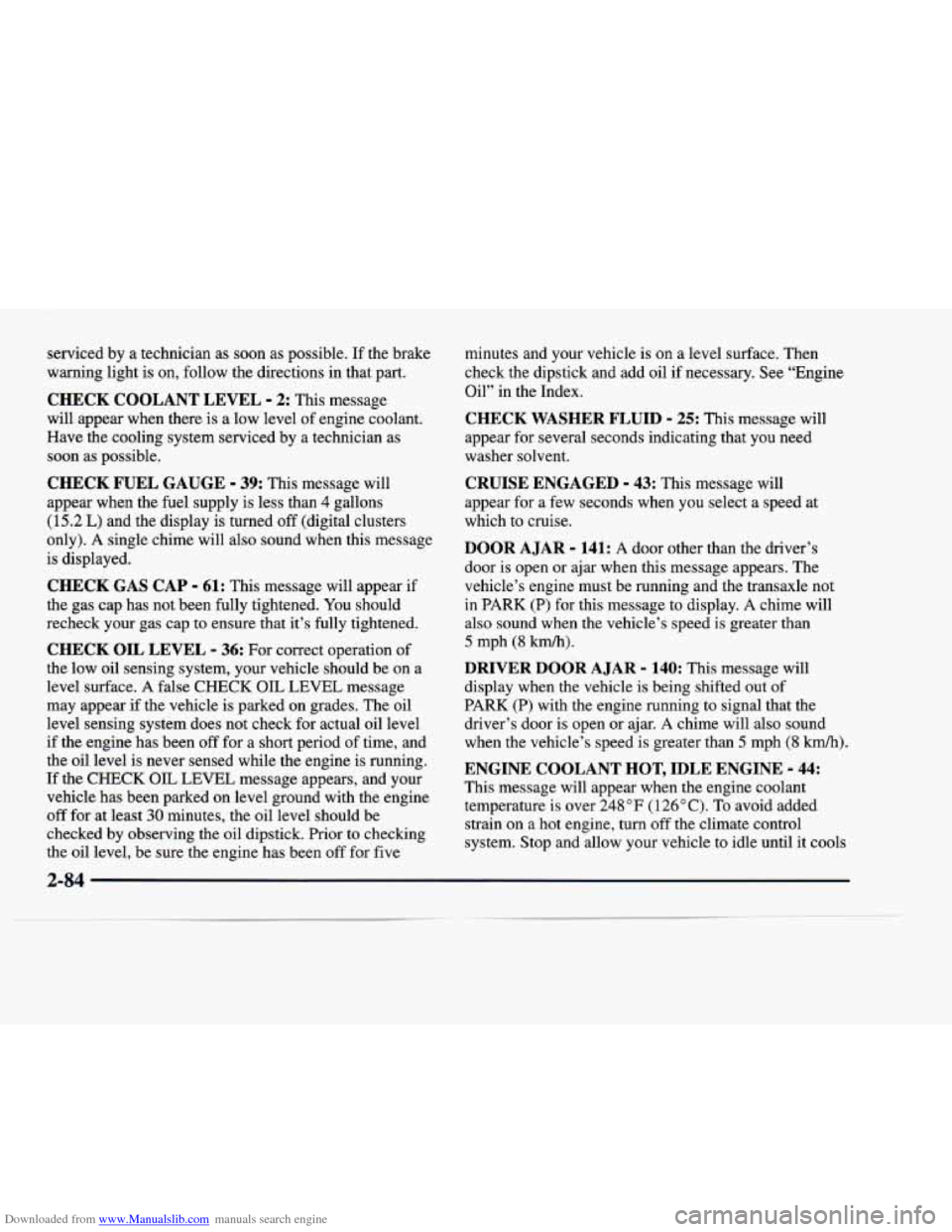
Downloaded from www.Manualslib.com manuals search engine serviced by a technician as soon as possible. If the brake
warning light is on, follow the directions in that part.
CHECK COOLANT LEVEL - 2: This message
will appear when there is a low level of engine coolant.
Have the cooling system serviced by a technician as
soon as possible.
CHECK FUEL GAUGE - 39: This message will
appear when the
fuel supply is less than 4 gallons
(15.2 L) and the display is turned off (digital clusters
only).
A single chime will also sound when this message
is displayed.
CHECK GAS CAP - 61: This message will appear if
the gas cap has not been fully tightened.
You should
recheck your gas cap to ensure that it’s fully tightened.
CHECK OIL LEVEL - 36: For correct operation of
the low oil sensing system, your vehicle should be on a
level surface. A false
CHECK OIL LEVEL message
may appear if the vehicle is parked on grades. The oil
level sensing system does not check for actual oil level
if the engine has been off for a short period of time, and
the oil level is never sensed while the engine is running.
If the
CHECK OIL LEVEL message appears, and your
vehicle has been parked on level ground with the engine
off for at least 30 minutes, the oil level should be
checked by observing the oil dipstick. Prior to checking
the oil level, be sure the engine has been
off for five minutes and your vehicle is on a level surface. Then
check the dipstick and add oil if necessary. See “Engine
Oil’’
in the Index.
CHECK WASHER FLUID - 25: This message will
appear for several seconds indicating that
you need
washer solvent.
CRUISE ENGAGED - 43: This message will
appear for a few seconds when you select a speed at
which to cruise.
DOOR A JAR - 141: A door other than the driver’s
door is open or ajar when this message appears. The
vehicle’s engine must be running and the transaxle not
in PARK (P) for this message to display. A chime will
also sound when the vehicle’s speed
is greater than
5 mph (8 km/h).
DRIVER DOOR A JAR - 140: This message will
display when the vehicle is being shifted out of
PARK (P) with the engine running to signal that the
driver’s door is open or ajar.
A chime will also sound
when the vehicle’s speed is greater than
5 mph (8 km/h).
ENGINE COOLANT HOT, IDLE ENGINE - 44:
This message will appear when the engine coolant
temperature is over
248 “F (1 26 O C). To avoid added
strain on a hot engine, turn off the climate control
system. Stop and allow your vehicle to idle until it cools
2-84
Page 156 of 386
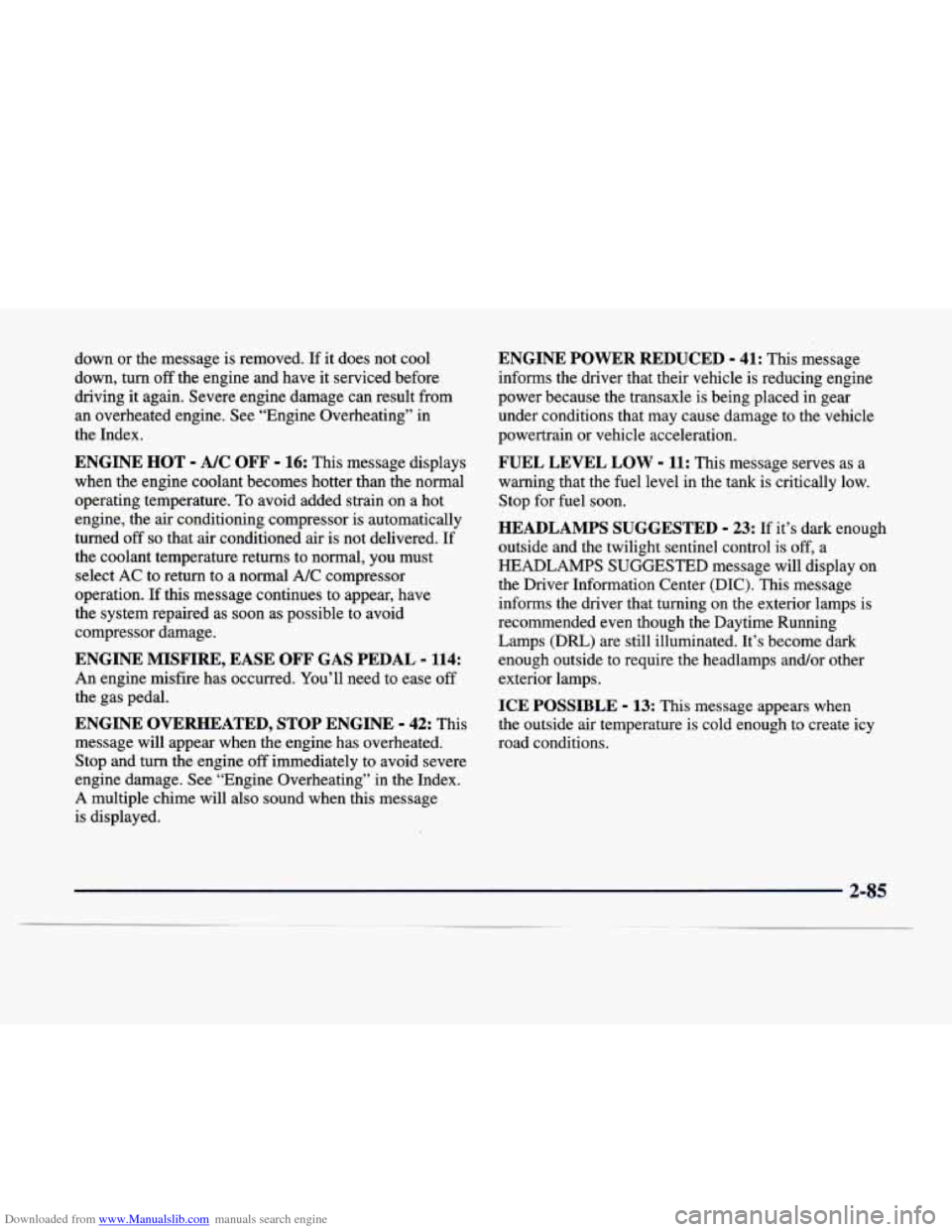
Downloaded from www.Manualslib.com manuals search engine down or the message is removed. If it does not cool
down, turn
off the engine and have it serviced before
driving it again. Severe engine damage can result from
an overheated engine. See “Engine Overheating”
in
the Index.
ENGINE HOT - NC OFF - 16: This message displays
when the engine coolant becomes hotter than the normal
operating temperature.
To avoid added strain on a hot
engine, the
air conditioning compressor is automatically
turned
off so that air conditioned air is not delivered. If
the coolant temperature returns to normal, you must
select AC to return
to a normal A/C compressor
operation. If this message continues to appear, have
the system repaired as soon as possible to avoid
compressor damage.
ENGINE MISFIRE, EASE OFF GAS PEDAL - 114:
An engine misfire has occurred. You’ll need to ease off
the gas pedal.
ENGINE OVERHEATED, STOP ENGINE - 42: This
message
will appear when the engine has overheated.
Stop and turn the engine
off immediately to avoid severe
engine damage. See “Engine Overheating” in the Index.
A multiple chime will also sound when this message
is displayed.
ENGINE POWER REDUCED - 41: This message
informs the driver that their vehicle is reducing engine
power because the transaxle is being placed in gear
under conditions that may cause damage to the vehicle
powertrain or vehicle acceleration.
FUEL LEVEL LOW - 11: This message serves as a
warning that the fuel level in the tank
is critically low.
Stop for fuel soon.
HEADLAMPS SUGGESTED - 23: If it’s dark enough
outside and the twilight sentinel control is
off, a
HEADLAMPS SUGGESTED message will display on
the Driver Information Center (DIC). This message
informs the driver that turning on the exterior lamps is
recommended even though the Daytime Running
Lamps (Dm) are still illuminated. It’s become dark
enough outside to require the headlamps andQr
exterior lamps.
ICE POSSIBLE - 13: This message appears when
the outside air temperature is cold enough to create icy
road conditions.
Page 158 of 386
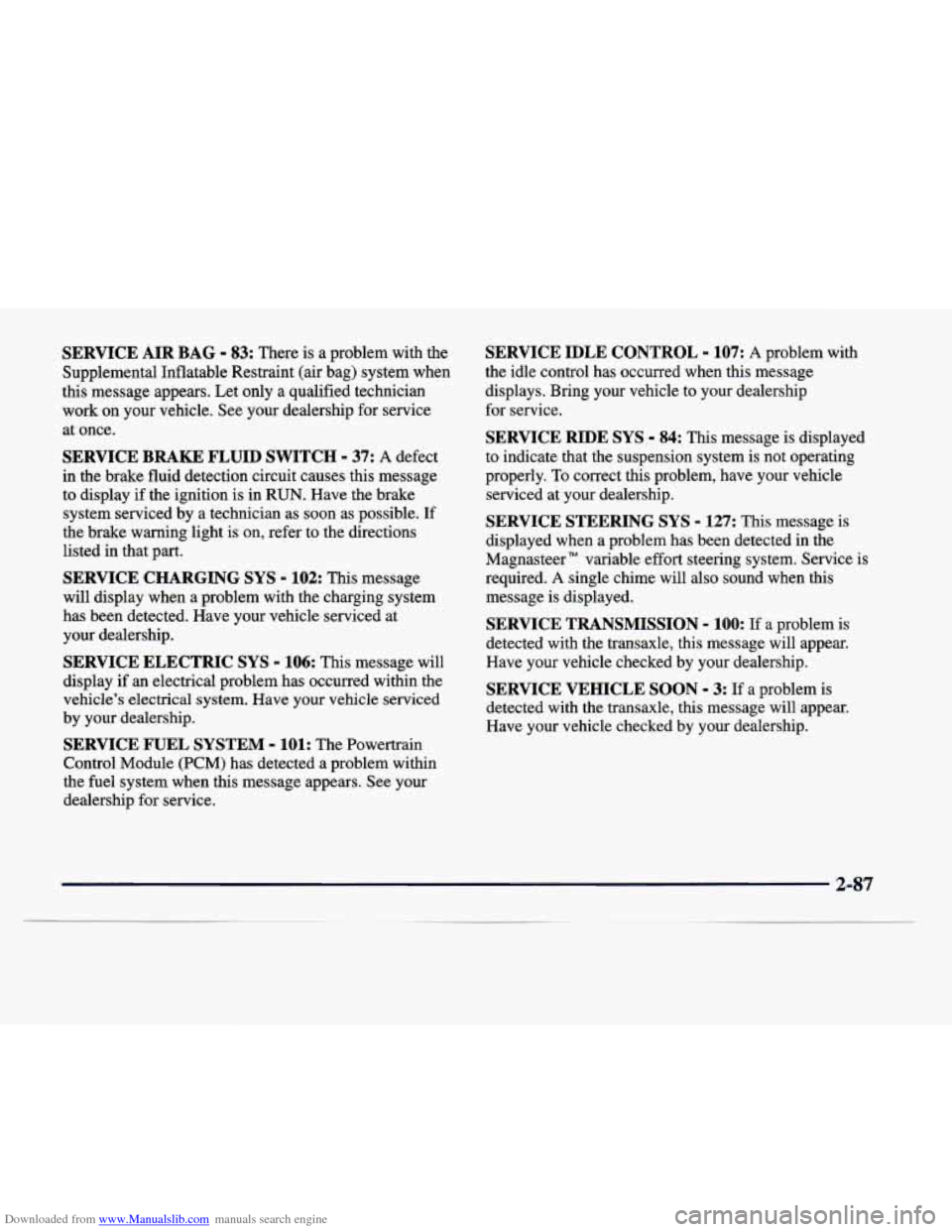
Downloaded from www.Manualslib.com manuals search engine SERVICE AIR BAG - 83: There is a problem with the
Supplemental Inflatable Restraint (air bag) system when
this message appears. Let only a qualified technician
work on your vehicle. See your dealership for service
at once.
SERVICE BRAKE FLUID SWITCH - 37: A defect
in the brake fluid detection circuit causes this message
to display if the ignition
is in RUN. Have the brake
system serviced by a technician as soon as possible.
If
the brake warning light is on, refer to the directions
listed in that part.
SERVICE CHARGING SYS - 102: This message
will display when a problem with the charging system
has been detected. Have your vehicle serviced at
your dealership.
SERVICE ELECTRIC SYS - 106: This message will
display
if an electrical problem has occurred within the
vehicle’s electrical system. Have your
vehicle serviced
by your dealership.
SERVICE FUEL SYSTEM - 101: The Powertrain
Control Module (PCM) has detected a problem within
the
fuel system when this message appears. See your
dealership for service.
SERVICE IDLE CONTROL - 107: A problem with
the idle control has occurred when this message
displays. Bring your vehicle to your dealership
for service.
SERVICE RIDE SYS - 84: This message is displayed
to indicate that the suspension system is not operating
properly. To correct this problem, have your vehicle serviced at your dealership.
SERVICE STEERING SYS - 127: This message is
displayed when a problem has been detected in the
Magnasteer” variable effort steering system. Service is
required.
A single chime will also sound when this
message is displayed.
SERVICE TRANSMISSION - 100: If a problem is
detected with the transaxle, this message will appear.
Have your vehicle checked by your dealership.
SERVICE VEHICLE SOON - 3: If a problem is
detected with the transaxle, this message will appear.
Have your vehicle checked by your dealership.
2-87
Page 218 of 386
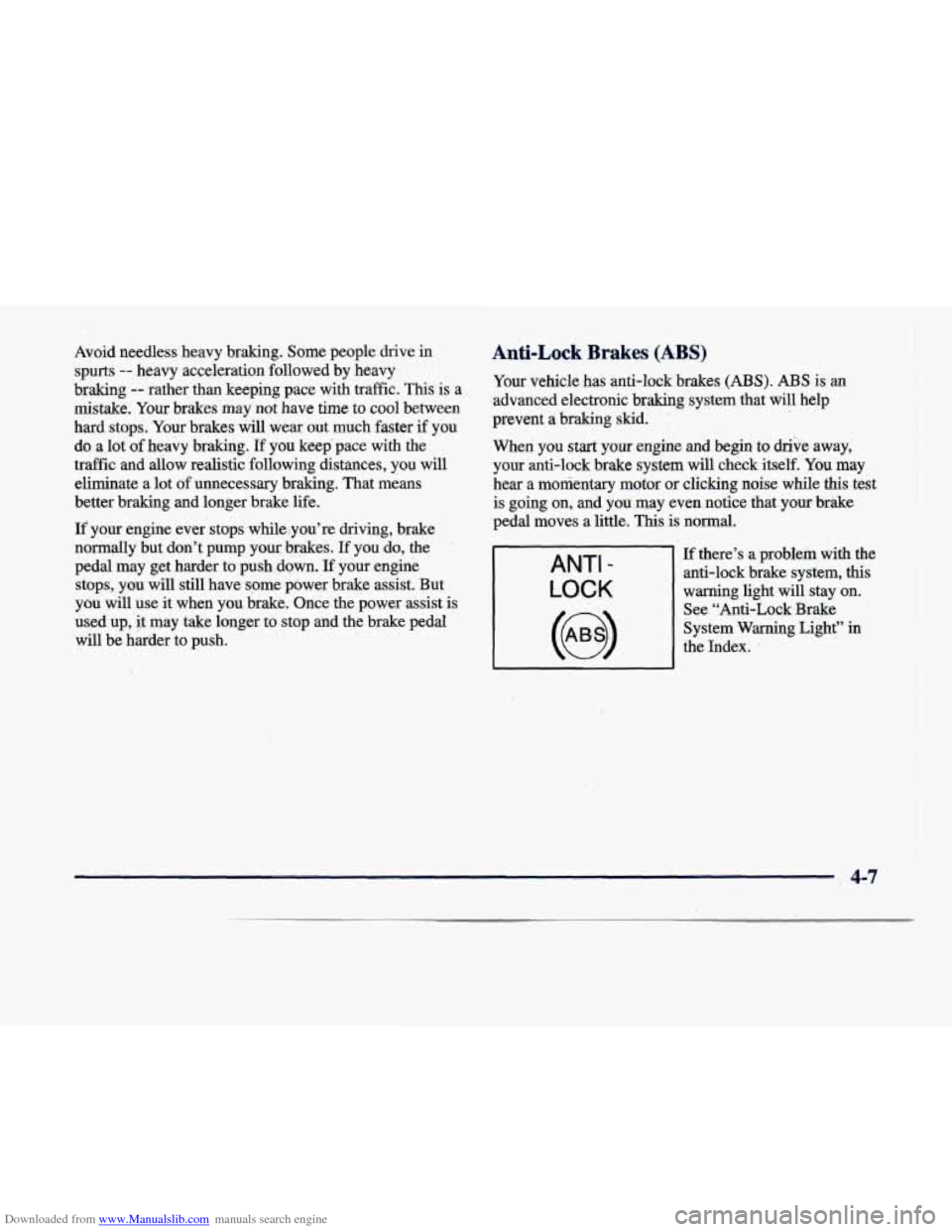
Downloaded from www.Manualslib.com manuals search engine Avoid needless’heavy braking. Some people drive in Anti-Lock Brakes (ABS)
spurts -- heavy acceleration followed by heavy
braking
-- rather than keeping pace with traffic.. This is a.
mistake. Your brakes may not have time to cool between
hard stops. ‘Your brakes will wear out much faster
if you Your
vehicle has anti-lock brakes
(ABS). ABS is an
,advanced electronic braking system that will help
prevent a braking skid.
do a lot of heavy braking.
If you keep pace with the
When you start your engine and begin to drive away,.
traffic and
allow realistic. following distances, you will
your anti-lock brake system will check itself. You may
eliminate a lot
of unnecessary braking. That means
hear a momentary motor or clicking noise while this test
better braking and longer brake life.
is going on, and you ‘may even notice that your brake
If your engine ever stops while,you’re driving, brake pedal moves a
little. This is normal.
no-&mlly but don’t pump your brakes.
If you do, the
pedal may get harder to push down.
If your engine
stops, you will still have some power brake assist. But
you will use it when you brake. Once the power assist is
used up,
it may take longer to stop and the brake pedal
will be harder to push.
ANTI -
LOCK
’ If there’s a problem with the
1 anti-lock brake system, this
warning light will stay on.
See “Anti-Lock Brake
System -Warning Light” in
the Index. ~
’( 4-7
Page 220 of 386
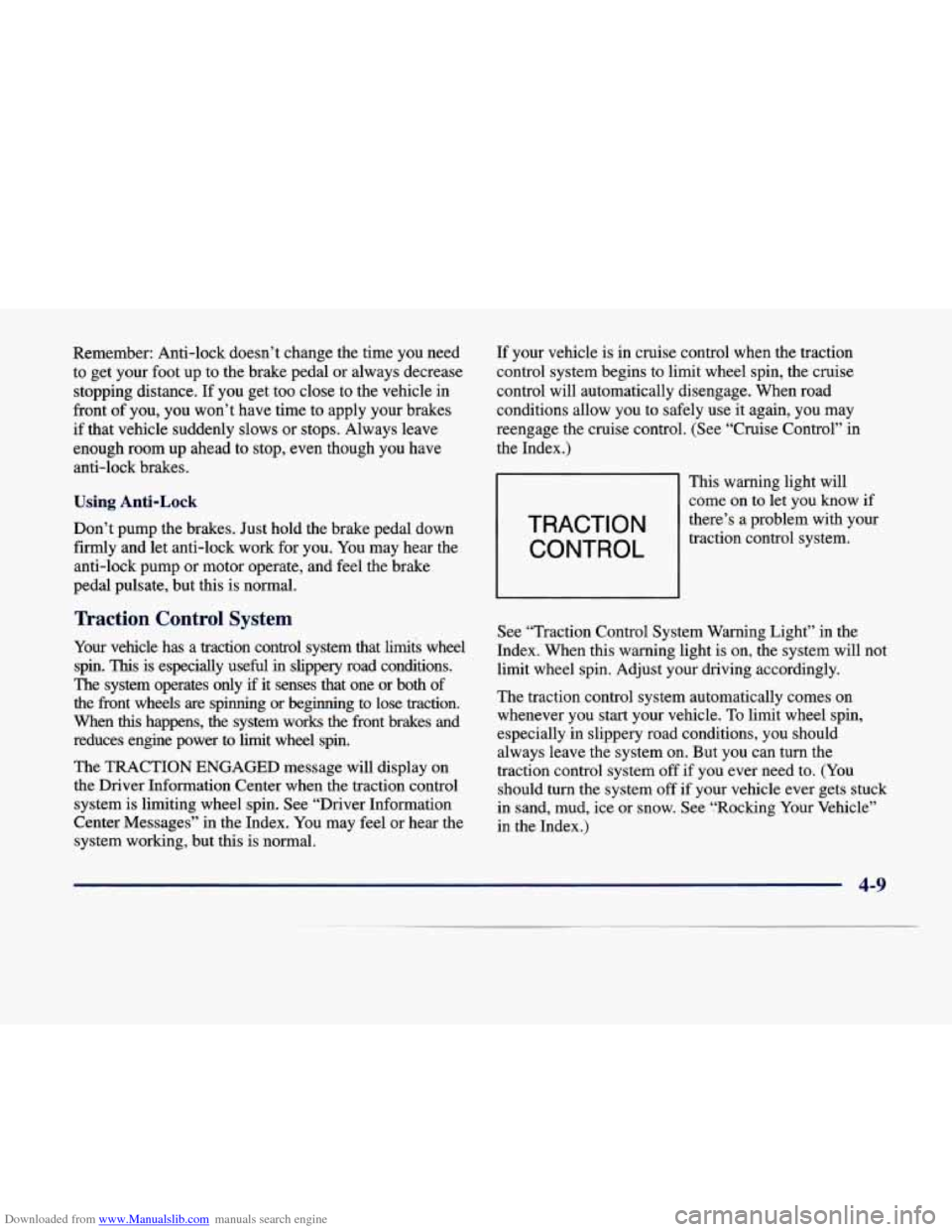
Downloaded from www.Manualslib.com manuals search engine Remember: Anti-lock doesn’t change the time you need to get your foot up to the brake pedal or always decrease
stopping distance.
If you get too close to the vehicle in
front of you, you won’t have time to apply your brakes
if that vehicle suddenly slows or stops. Always leave
enough room up ahead to stop, even though you have anti-lock brakes.
Using Anti-Lock
Don’t pump the brakes. Just hold the brake pedal down
firmly and let anti-lock work for you. You may hear the
anti-lock pump or motor operate, and
1 1 the brake
pedal pulsate, but this is normal.
Traction Control System
Your vehicle has a traction control system that limits wheel
spin.
This is especially useful in slippery road conditions.
The system operates only
if it senses that one or both of
the front wheels are spinning or beginning to lose traction.
When
this happens, the system works the front brakes and
reduces engine power to limit wheel spin.
The TRACTION
ENGAGED message will display on
the Driver Information Center when the traction control
system is limiting wheel spin. See “Driver Information
Center Messages” in the Index. You may feel or hear the
system working, but this is normal. If
your vehicle is in cruise control when the traction
control system begins to limit wheel spin, the cruise
control will automatically disengage. When road
conditions allow
you to safely use it again, you may
reengage the cruise control. (See “Cruise Control” in
the Index.)
TRACTION
CONTROL
This warning light will come on to let you know if
there’s a problem with your
traction control system.
See “Traction Control System Warning Light” in the
Index. When this warning light is on, the system will not
limit wheel spin. Adjust your driving accordingly.
The traction control system automatically comes on whenever you start your vehicle. To limit wheel spin,
especially in slippery road conditions, you should always leave the system
on. But you can turn the
traction control system
off if you ever need to. (You
should turn the system
off if your vehicle ever gets stuck
in sand, mud, ice or snow. See ‘.‘Rocking Your Vehicle”
in the Index.)
4-9
Page 231 of 386
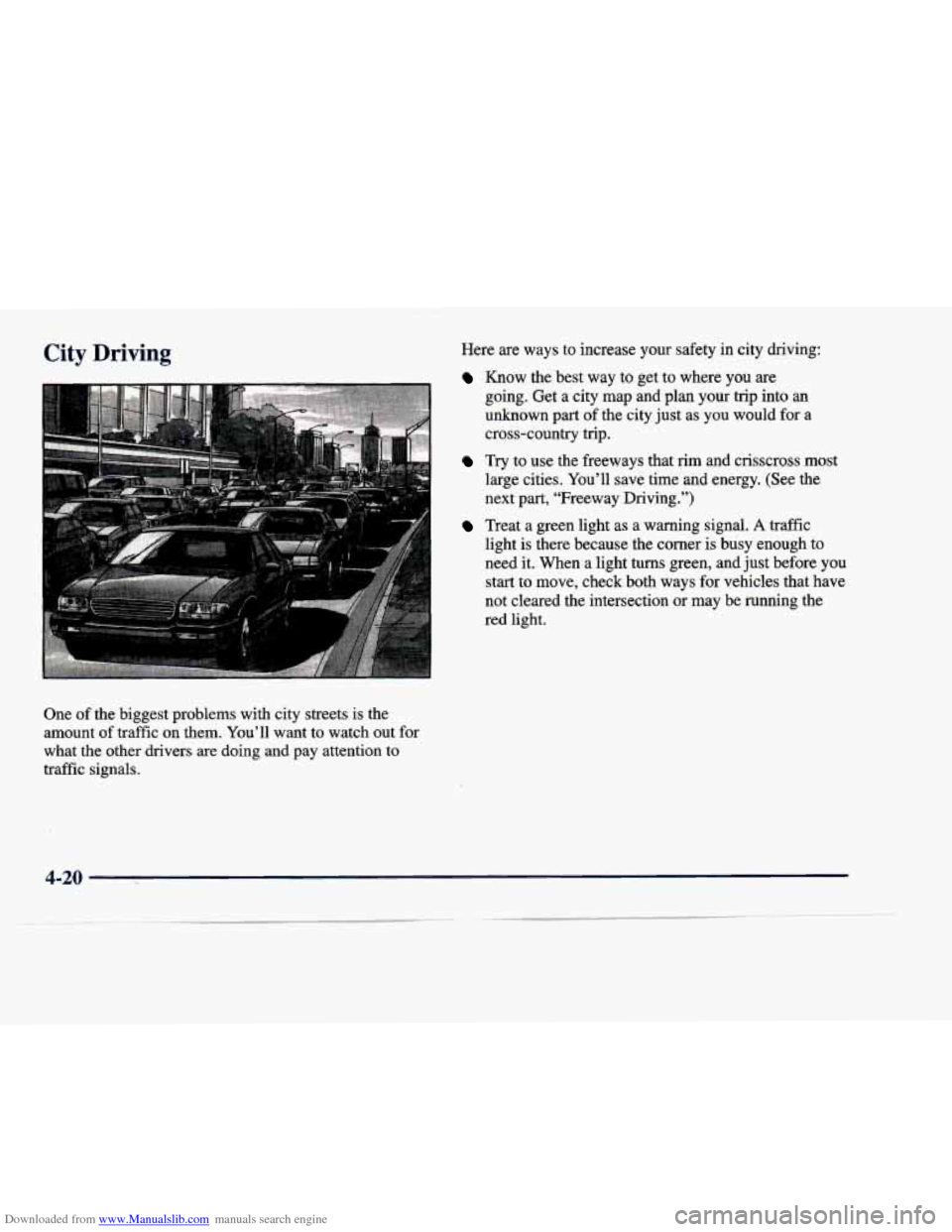
Downloaded from www.Manualslib.com manuals search engine City Driving Here are ways to increase your safety in city driving:
Know the best way to get to where you are
going. Get
a city map and plan your trip into an
unknown part of the city just as you would for a
cross-country trip.
Try to use the freeways that rim and crisscross most
large cities. You’ll save time and energy. (See the
next part, “Freeway Driving.”)
One
of the biggest problems with city streets is the
amount
of traffic on them. You’ll want to watch out for
what the other drivers are doing and pay attention to
traffic signals.
Treat a green light as a warning signal. A traffic
light is there because the comer is busy enough to
need it. When
a light turns green, and just before you
start to move, check both ways for vehicles that have
not cleared the intersection or may be running the
red light.
4-20
Page 236 of 386
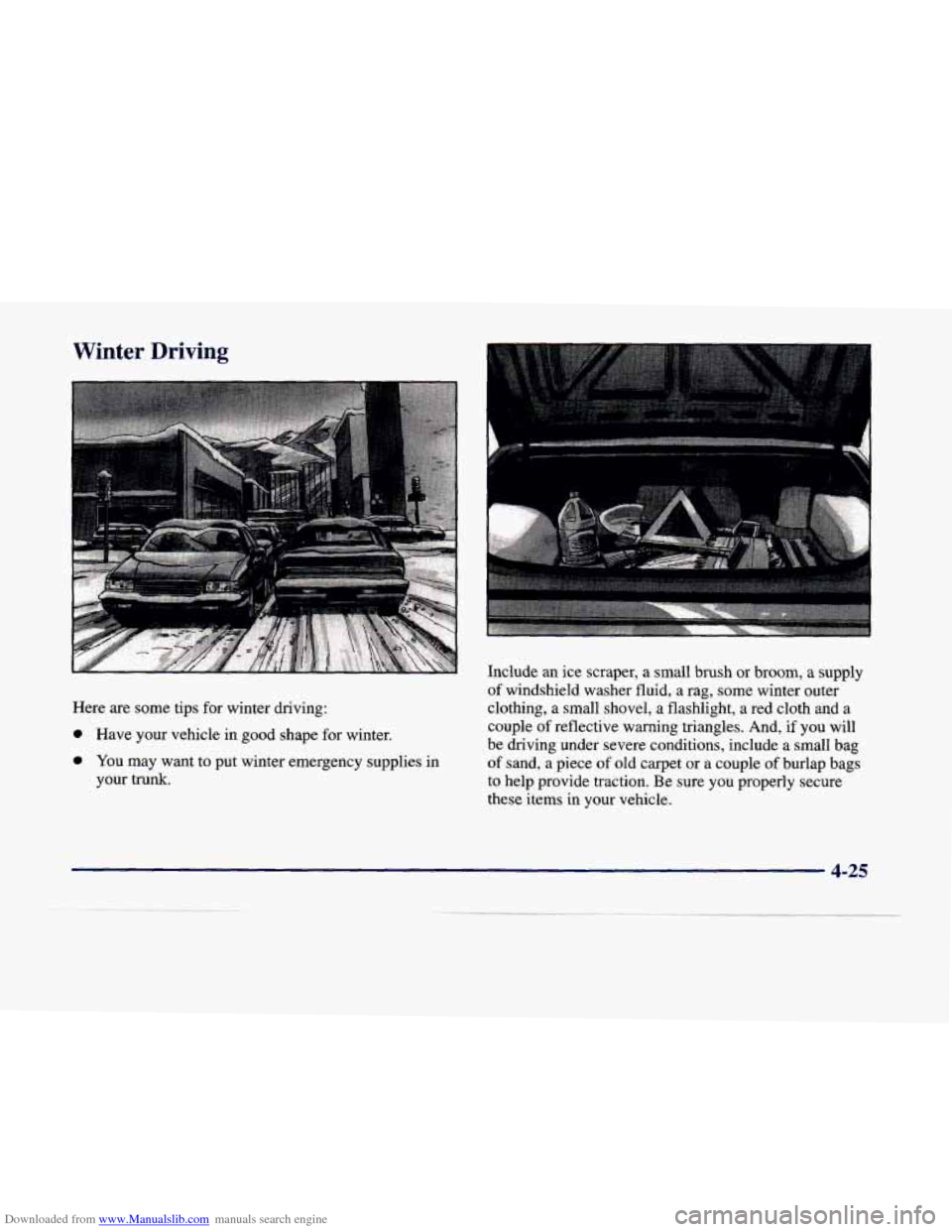
Downloaded from www.Manualslib.com manuals search engine Winter Driving
Here are some tips for winter driving:
0 Have your vehicle in good shape for winter.
0 You may want to put winter emergency supplies in
your trunk. Include an ice scraper,
a small brush or broom,
a supply
of windshield washer fluid, a rag, some winter outer
clothing, a small shovel, a flashlight,
a red cloth and a
couple
of reflective warning triangles. And, if you will
be driving under severe conditions, include a small bag
of sand, a piece
of old carpet or a couple of burlap bags
to help provide traction. Be sure you properly secure
these items in your vehicle.
4-25
Page 251 of 386

Downloaded from www.Manualslib.com manuals search engine Hazard Warning Flashers
Your hazard warning flashers let you warn others. They
also let police
know you have a problem. Your front and
rear turn signal lamps will flash on and off. Press the button in to make
lamps flash on and off,
A
the front and rear turn signal
This light on the instrument
panel will flash, indicating
that the hazard warning
flashers
are on.
The hazard warning flashers will
work once the button
is pressed
in regardless of the key position.
5-2
Page 264 of 386
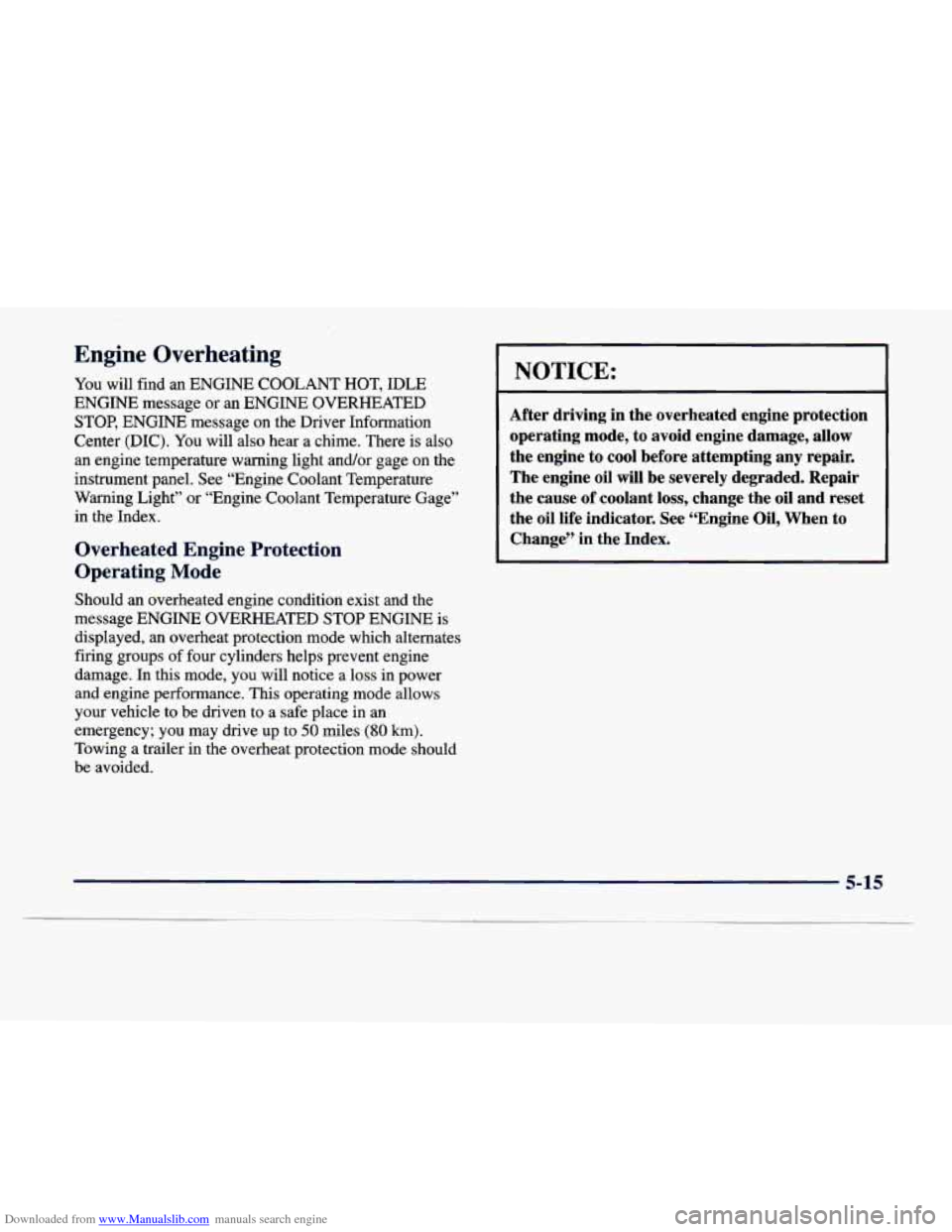
Downloaded from www.Manualslib.com manuals search engine Engine Overheating
You will find an ENGINE COOLANT HOT, IDLE
ENGINE message or an ENGINE
OVERHEATED
STOP, ENGINE message on the Driver Information
Center (DIC). You will
also hear a chime. There is also
an engine temperature warning light andor gage on the
instrument panel. See “Engine Coolant Temperature
Warning Light” or “Engine Coolant Temperature Gage”
in the Index.
Overheated Engine Protection
Operating Mode
NOTICE:
After driving in the overheated engine protection
operating mode, to avoid engine damage, allow
the engine to cool before attempting any repair.
The engine oil will be severely degraded. Repair
the cause of coolant loss, change the oil and reset
the oil life indicator. See “Engine Oil, When to
Change” in the Index.
Should an overheated engine condition exist and the
message ENGINE OVERHEATED STOP ENGINE is
displayed, an overheat protection mode which alternates
firing groups
of four cylinders helps prevent engine
damage.
In this mode, you will notice a loss in power
and engine performance. This operating mode allows
your vehicle to be driven to a safe place in
an
emergency; you may drive up to 50 miles (80 lun).
Towing a trailer in the overheat protection mode should
be avoided.
5-15